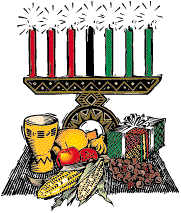

Kwanzaa is a holiday that honors African American people and their past. It begins on December 26 and lasts for seven days until January 1. It is not a religious holiday like Christmas or Hanukkah.
Kwanzaa was first celebrated in 1966 by an African American teacher named Dr. Maulana Karenga. Dr. Kearenga started the holiday so that African American people could learn about their African history and customs.
When Dr. Karenga began planning a celebration for African Americans, he looked at their history. He learned that the sncestors of many African Americans came from the western part of Africa. Many of the ethnic groups or tribes that African Americans descended from have their own languages and ways of communicating. Dr. Karenga searched for an African laanguage that represented all Africans to explain his holiday.
He chose the word "Kwanzaa" from the Swahili language, which is an East African language that is not tied to any specific ethnic group or tribe. The word "Kwanzaa" itself is a Swahili word that means "first fruits of the arvest." Harvest is a word that means to "gather the fruits and vegetables that were planted in the rainy season." It is a custom in Africa to celebraate the harvest before the beginning of the dry season.
Kwanzaa was also created as a way for African Americans to create their own customs. Most customs begin because family and friends spend time together. Kwanzaa is a way for people to welcome each other into their homes, and to study about Africa and the history of African Americans.
Kwanzaa is also a time to celebrate. Family and friends gather during Kwanzaa to share food and exchange presents. In this way, Kwanzaa celebrates unity, or people being together, as they learn about their shared history.
When Dr. Karenga thought about Kwanzaa, he looked for a symbol or sign that would mean something special to African Americans. Dr. Karenga learned that a great leader named Marcus Garvey had already created a flag for African Americans. This flag is called a bendera. The bendera is green, black, and red. The green stripe on the bottom stands for the African land and the future hopes and dreams of African Americans. It also stands for fairness and freedom. The black stripe in the middle stands for unity and togetherness of all black people. The red stripe on the top stands for the struggle of the past and present.
Dr. Karenga thought it was especially important for African American families to proudly display the bendera during Kwanzaa. He believed that the bendera represents African American people, their families and their history, and the role they play in making the world a better place.
|
|
|
|
|
|
PAGE DESIGNED BY DEBBIE DE